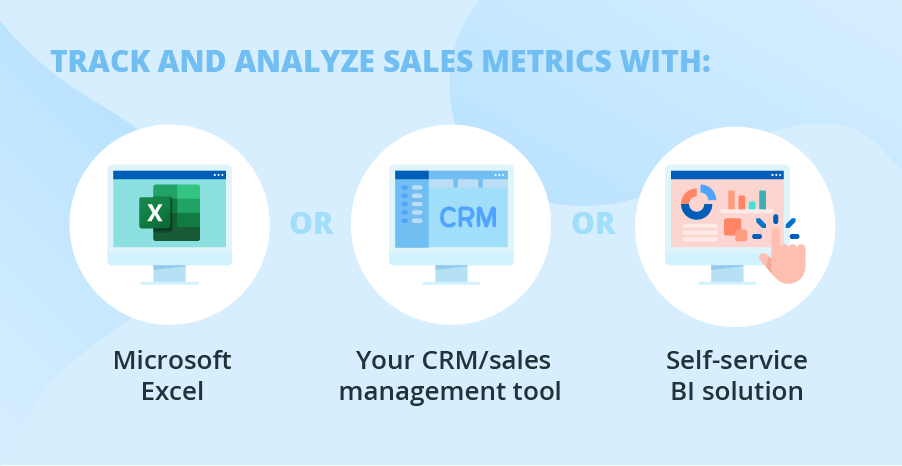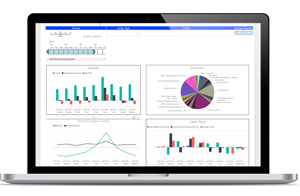Editor’s note: In the article, Irene explains why measuring sales performance is so important for sales growth and shares three examples of how a company can facilitate this process. If you feel that you need assistance with your sales analytics, consider turning to ScienceSoft’s data analytics consulting services.
Out of major industries, retail is one of the most susceptible to changing consumer needs and the dynamic economic environment. To meet your sales goals month after month in such circumstances, you need to constantly assess your company’s performance and make quick adjustments.
In this article, I’ll share with you some examples of sales metrics you need to track to stay in the know about your sales performance and three options to facilitate their analysis.
What sales metrics to analyze?
Sales metrics are quantifiable measures that help you assess the effectiveness of a salesperson, a sales team, the whole organization (sales productivity metrics), the sales process or its aspect (sales performance metrics) against set objectives.
Due to the abundance of all-rounded sales data, many of ScienceSoft’s clients face the dilemma of which sales metrics they need to track when there are dozens available. As analyzing the right metrics is crucial for spotting critical information about your sales process, I advise companies to carefully choose individual KPIs based on their industry and short-term and long-term business goals.
Among the common sales metrics I usually recommend tracking are:
-
Win/conversion rate
This sales performance measurement shows the percentage of leads that convert into customers, and it is used for forecasting your revenue objectives. The conversion rate also measures the effectiveness of your sales activities: if the win rate is increasing with the same or higher number of closed deals, sales team performance is improving.
-
Average deal size
To calculate the average deal size, you have to divide the total revenue from the closed deals by the number of those deals. This metric is particularly important for those companies who plan to move upmarket – the bigger the deal size, the closer they are to enterprise-level contracts.
-
Sales-to-cost ratio
To understand the profitability of a sale, you should calculate your sales-to-cost ratio. For that, you compare the revenue you earn from the deal to the cost of acquiring it. Should you find out that the revenue you earn from securing a deal is only enough to cover the expenses, some urgent actions are required – searching for the ways to reduce costs, shortening your sales cycle, rethinking your target market, etc.
-
Sales funnel leakage
Your sales funnel consists of a certain number of stages, each of which can lead to winning or losing a sale. Only by monitoring your stage-by-stage conversion, you’ll be able to define at which stage your leads are likely to quit business with you. The quicker you define and eliminate weak points in your conversion funnel, the higher your win rate will be.
How to track and analyze sales metrics?

When the key sales metrics to analyze are defined, the challenge arises to provide business users with seamless and timely access to their analysis. For that, you have to develop an effective sales analysis environment and get the right software in place. Here are some common in-house options:
-
Microsoft Excel
Among Excel advantages, I may point out its sufficiency as a personal solution for analyzing historical data, plus it is affordable and comparatively easy to master. However, the tool is not effective for collaboration and forecasting. What is more, all the information has to be entered into Excel manually, which is extremely time-consuming and can result in numerous errors. Consequently, the accuracy of the analysis will be greatly impaired.
-
Analytics capabilities of your CRM/sales management tool
A CRM system compiling all-rounded information about your clients from a variety of sources can help you derive actionable insights crucial for achieving your sales goals. For example, you can learn which communication channels bring more value, the cost of acquiring customers, best up-selling and cross-selling opportunities, and much more. But to be fair, not every CRM software is capable of that. Your CRM can be considered effective for sales analysis if it has:
- Vast analytical capabilities that facilitate customer segmentation to optimize marketing and sales processes, forecast challenges approaching through the sales pipeline, etc.
- Powerful integration capabilities to connect to data sources (ecommerce platform, social media, store software, etc.) needed for conducting comprehensive sales analysis.
- Setup data management procedures to ensure high data quality.
- Intuitive visualization to allow getting a visual snapshot of the metrics.
For a real-life example of utilizing CRM capabilities for sales analytics, have a look at one of our projects, in which ScienceSoft implemented and customized a CRM system to allow a multibusiness company to gain greater visibility into daily operations.
-
Self-service business intelligence solution
With a well set-up and tuned self-service BI solution, you get:
- A central repository of aggregated and cleansed sales data from integrated corporate applications, as well as from external data sources. That way, you can connect to all data required for getting a holistic view of the whole sales cycle.
- Profound analytical capabilities powered by data science and machine learning, which are applied to your sales data to find the answers to most deliberate questions. Besides understanding the reasons behind certain sales performance, you can get detailed recommendations on how to enhance the performance of your sales team, what stages of your sales pipeline require immediate adjustments, and what corrective actions to your sales funnel will bring maximum ROI.
- Self-service visualization and reporting functionality, which bring sales analytics at your fingerprints. With informative and easy-to-digest reports and dashboards, you can track your key sales metrics in real time to conduct benchmarking, define hurdles to hitting your sales quota and obtain insights into how to improve your sales team’s performance and the whole sales process. To see how it works in practice, watch our BI demo.
The key to successful selling
I’m sure that the key to remaining competitive on the market with timely and accurate decisions is the right analytics solution. The article outlined some of the in-house solutions for tracking and analyzing sales metrics. But surely, an in-house solution is not the only way to go. If having an analytics solution inside your organization is not an option, you can always opt for outsourcing. If you feel that you need help with defining your most fitting sales analytics option, don’t hesitate to reach out to ScienceSoft’s consultants.

Are you striving for informed decision-making? We will convert your historical and real-time data into actionable insights and set up forecasting.
